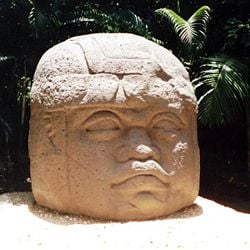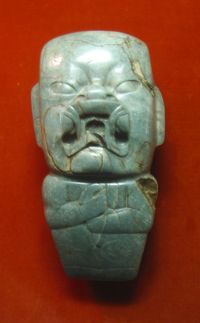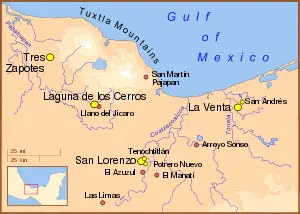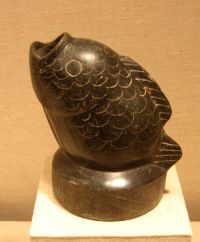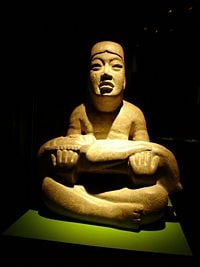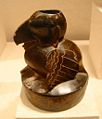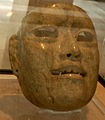Difference between revisions of "Olmec" - New World Encyclopedia
m |
|||
| Line 13: | Line 13: | ||
==History of scholarly research on the Olmec== | ==History of scholarly research on the Olmec== | ||
| + | [[Image:Kunz Axe.jpg|right|200px|thumb|The jade Kunz Axe, first described by George Kunz in 1890. Although shaped like an axe head, with an edge along the bottom, it is unlikely that this artifact was used except in ritual settings.<br/> Height: 11 in (28 cm).]] | ||
Olmec culture was unknown to historians until the mid-19th century. In 1862 the fortuitous discovery of a colossal head near [[Tres Zapotes]], [[Veracruz]] by José Melgar y Serrano<ref>Stirling, Matthew (1967) "Early History of the Olmec Problem," in [http://www.doaks.org/Olmec.pdf ''Dumbarton Oaks Conference on the Olmec''], E. Benson, ed., Dumbarton Oaks,Washingtonn, D.C.</ref> marked the first significant rediscovery of Olmec artifacts. In the latter half of the 19th century, Olmec artifacts such as the Kunz Axe (right) came to light and were recognized as belonging to a unique artistic tradition. | Olmec culture was unknown to historians until the mid-19th century. In 1862 the fortuitous discovery of a colossal head near [[Tres Zapotes]], [[Veracruz]] by José Melgar y Serrano<ref>Stirling, Matthew (1967) "Early History of the Olmec Problem," in [http://www.doaks.org/Olmec.pdf ''Dumbarton Oaks Conference on the Olmec''], E. Benson, ed., Dumbarton Oaks,Washingtonn, D.C.</ref> marked the first significant rediscovery of Olmec artifacts. In the latter half of the 19th century, Olmec artifacts such as the Kunz Axe (right) came to light and were recognized as belonging to a unique artistic tradition. | ||
| Line 20: | Line 21: | ||
==Time-line== | ==Time-line== | ||
| − | [[Image:Olmec Heartland Overview 4.svg| | + | [[Image:Olmec Heartland Overview 4.svg|thumb|left|300px|The Olmec heartland.]] |
Olmec history originated at its base within San Lorenzo Tenochtitlán, where distinctively Olmec features begin to emerge before 1200 B.C.E.<ref>Diehl, Richard A. ''TheOlmecs: America's First Civilization'' (Thames & Hudson 2005, ISBN 0500285039)</ref> The Olmec heartland is characterized by swampy lowlands punctuated by low hills, ridges, and volcanoes. The [[Sierra de Los Tuxtlas|Tuxtlas Mountains]] rise sharply in the north, along the Gulf of Mexico's [[Bay of Campeche]]. The rise of civilization here was probably assisted by the local ecology of well-watered rich [[alluvial]] soil, encouraging high [[maize]] production. This ecology may be compared to that of other ancient centers of civilization: the [[Nile]], [[Indus]], and [[Yellow River]] valleys, and [[Mesopotamia]]. | Olmec history originated at its base within San Lorenzo Tenochtitlán, where distinctively Olmec features begin to emerge before 1200 B.C.E.<ref>Diehl, Richard A. ''TheOlmecs: America's First Civilization'' (Thames & Hudson 2005, ISBN 0500285039)</ref> The Olmec heartland is characterized by swampy lowlands punctuated by low hills, ridges, and volcanoes. The [[Sierra de Los Tuxtlas|Tuxtlas Mountains]] rise sharply in the north, along the Gulf of Mexico's [[Bay of Campeche]]. The rise of civilization here was probably assisted by the local ecology of well-watered rich [[alluvial]] soil, encouraging high [[maize]] production. This ecology may be compared to that of other ancient centers of civilization: the [[Nile]], [[Indus]], and [[Yellow River]] valleys, and [[Mesopotamia]]. | ||
| − | [[Image:La Venta Stele 19.jpg|thumb|right| | + | [[Image:La Venta Stele 19.jpg|thumb|right|200px|Monument 19 from La Venta is the earliest known representation of a feathered serpent in Mesoamerica.<br/><small>© George & Audrey DeLange, used with permission.</small>]]San Lorenzo was all but abandoned around 900 B.C.E. at about the same time that [[La Venta]] rose to prominence. Environmental changes may have been responsible for this move, with certain important rivers changing course. A wholesale destruction of many San Lorenzo monuments also occurred around this time, [[circa]] 950 B.C.E., which may point to an internal uprising or, less likely, an invasion.<ref>Coe, M.D. (1967) "San Lorenzo and the Olmec Civilization," in [http://www.doaks.org/Olmec.pdf ''Dumbarton Oaks Conference on the Olmec''], Dumbarton Oaks,Washingtonn, D.C.</ref> Following the decline of San Lorenzo, La Venta became the most prominent Olmec center, lasting from 900 B.C.E. until its abandonment around 400 B.C.E. During this period, the [[La Venta#Great Pyramid|Great Pyramid]] and various other ceremonial complexes were built at La Venta.<ref> Diehl, Richard A. TheOlmecs: America's First Civilization (Thames & Hudson 2005, ISBN 0500285039)</ref> |
It is not known with any clarity what caused the eventual extinction of the Olmec culture. It ''is'' known that between 400 and 350 B.C.E., population in the eastern half of the Olmec heartland dropped precipitously, and the area would remain sparsely inhabited until the 19th century.<ref> Diehl, Richard A. The Olmec: America's First Civilization (Thames & Hudson 2005, ISBN 0500285039)</ref> This depopulation was likely the result of environmental changes: perhaps the result of important rivers changing course or silting up due to agricultural practices.<ref> Diehl, Richard A. The Olmec: America's First Civilization (Thames & Hudson 2005, ISBN 0500285039)</ref> | It is not known with any clarity what caused the eventual extinction of the Olmec culture. It ''is'' known that between 400 and 350 B.C.E., population in the eastern half of the Olmec heartland dropped precipitously, and the area would remain sparsely inhabited until the 19th century.<ref> Diehl, Richard A. The Olmec: America's First Civilization (Thames & Hudson 2005, ISBN 0500285039)</ref> This depopulation was likely the result of environmental changes: perhaps the result of important rivers changing course or silting up due to agricultural practices.<ref> Diehl, Richard A. The Olmec: America's First Civilization (Thames & Hudson 2005, ISBN 0500285039)</ref> | ||
| Line 35: | Line 36: | ||
The Olmec were likely the originators of the [[Mesoamerican ballgame]] so prevalent among later cultures of the region and used for recreational and religious purposes.<ref>Pool, Christopher ''Olmec Archaeology and Early Mesoamerica'' (Cambridge University Press 1997, ISBN 052178882X</ref> A dozen rubber balls dating to 1600 B.C.E. or earlier have been found in [[El Manatí]], an Olmec sacrificial [[bog]] 10kilometerss east of San Lorenzo Tenochtitlan.<ref>Ortíz C., Ponciano; Rodríguez, María del Carmen (1999) [http://www.doaks.org/Social/social09.pdf "Olmec Ritual Behavior at El Manatí: A Sacred Space"] in ''Social Patterns in Pre-Classic Mesoamerica'', eds. Grove, D. C.; Joyce, R. A., Dumbarton Oaks Research Library and Collection, Washington, D.C., p. 225 - 254.</ref> These balls predate the earlball-courtcourt yet discovered at [[Paso de la Amada]], [[circa]] 1400 B.C.E. The fact that the balls were found with other sacrificial items, including pottery and [[jadeite]] [[celt (tool)|celts]] indicates that even at this early date, the ballgame had religious and ritual connotations. The rules of the ballgame are not known, but judging from its descendant, [[ulama]], which is still practiceindigenousnious natives in [[South America]], it was probably similar to [[racquetball]] or [[volleyball]], where the aim is to keep the ball in play. | The Olmec were likely the originators of the [[Mesoamerican ballgame]] so prevalent among later cultures of the region and used for recreational and religious purposes.<ref>Pool, Christopher ''Olmec Archaeology and Early Mesoamerica'' (Cambridge University Press 1997, ISBN 052178882X</ref> A dozen rubber balls dating to 1600 B.C.E. or earlier have been found in [[El Manatí]], an Olmec sacrificial [[bog]] 10kilometerss east of San Lorenzo Tenochtitlan.<ref>Ortíz C., Ponciano; Rodríguez, María del Carmen (1999) [http://www.doaks.org/Social/social09.pdf "Olmec Ritual Behavior at El Manatí: A Sacred Space"] in ''Social Patterns in Pre-Classic Mesoamerica'', eds. Grove, D. C.; Joyce, R. A., Dumbarton Oaks Research Library and Collection, Washington, D.C., p. 225 - 254.</ref> These balls predate the earlball-courtcourt yet discovered at [[Paso de la Amada]], [[circa]] 1400 B.C.E. The fact that the balls were found with other sacrificial items, including pottery and [[jadeite]] [[celt (tool)|celts]] indicates that even at this early date, the ballgame had religious and ritual connotations. The rules of the ballgame are not known, but judging from its descendant, [[ulama]], which is still practiceindigenousnious natives in [[South America]], it was probably similar to [[racquetball]] or [[volleyball]], where the aim is to keep the ball in play. | ||
| − | [[Image:La Venta Altar 5 (Ruben Charles).jpg|thumb|right| | + | [[Image:La Venta Altar 5 (Ruben Charles).jpg|thumb|right|250px|Altar 5 from La Venta. The inert were-jaguar baby held by the central figure is seen by some as an indication of child sacrifice. In contrast, [[:Image:Altar 5 from La Venta, left side (Ruben Charles).jpg|its sides show bas-reliefs of humans holding quite lively were-jaguar babies]].]] |
===Bloodletting and sacrifice=== | ===Bloodletting and sacrifice=== | ||
| Line 50: | Line 51: | ||
There are also well-documented later hieroglyphs known as "[[Epi-Olmec script|Epi-Olmec]]," and while there are some who believe that Epi-Olmec may represent a transitional script between an earlier Olmec writing system and [[Maya civilization|Maya]] writing, the matter remains unsettled. | There are also well-documented later hieroglyphs known as "[[Epi-Olmec script|Epi-Olmec]]," and while there are some who believe that Epi-Olmec may represent a transitional script between an earlier Olmec writing system and [[Maya civilization|Maya]] writing, the matter remains unsettled. | ||
| − | [[Image:Tres Zapotes Stela.C.back.Pt1.jpg|thumb| | + | [[Image:Tres Zapotes Stela.C.back.Pt1.jpg|thumb|200px|right|'''The back of Stela C from [[Tres Zapotes]]'''<br/>This is the second oldest Long Count date yet discovered. The numerals 7.16.6.16.18 translate to September 3, 32 B.C.E. (Julian). The glyphs surrounding the date are what is thought to be one of the few surviving examples of [[Epi-Olmec script]].]] |
Even less is known about the spoken language of the Olmec. In 1976 [[Lyle Campbell]] and Terrence Kaufman published a paper which argued that there are a core number of loanwords which have apparently spread from a Mixe-Zoquean language into many other [[Mesoamerican languages]].<ref>Campbell, L., and T. Kaufman, "A Linguistic Look at the Olmec," ''American Antiquity'', Vol. 41, No. 1 (Jan., 1976), pp. 80-89</ref> Campbell and Kaufman go on to argue that these core loanwords can be seen as an indicator that the Olmec, the first "highly civilized society" of Mesoamerica, spoke a language which is an ancestor of the [[Mixe-Zoquean languages]], and that they spread a vocabulary particular to their culture to the other peoples of Mesoamerica.<ref>Campbell, L., and T. Kaufman, "A Linguistic Look at the Olmec," ''American Antiquity'', Vol. 41, No. 1 (Jan., 1976), pp. 80-89</ref> | Even less is known about the spoken language of the Olmec. In 1976 [[Lyle Campbell]] and Terrence Kaufman published a paper which argued that there are a core number of loanwords which have apparently spread from a Mixe-Zoquean language into many other [[Mesoamerican languages]].<ref>Campbell, L., and T. Kaufman, "A Linguistic Look at the Olmec," ''American Antiquity'', Vol. 41, No. 1 (Jan., 1976), pp. 80-89</ref> Campbell and Kaufman go on to argue that these core loanwords can be seen as an indicator that the Olmec, the first "highly civilized society" of Mesoamerica, spoke a language which is an ancestor of the [[Mixe-Zoquean languages]], and that they spread a vocabulary particular to their culture to the other peoples of Mesoamerica.<ref>Campbell, L., and T. Kaufman, "A Linguistic Look at the Olmec," ''American Antiquity'', Vol. 41, No. 1 (Jan., 1976), pp. 80-89</ref> | ||
| Line 68: | Line 69: | ||
===Art=== | ===Art=== | ||
Olmec artforms remain in works of both monumental statuary and small [[jade]]work. Much Olmec art is highly stylized and uses an iconography reflective of a religious meaning. Some Olmec art, however, is surprisingly naturalistic, displaying an accuracy of depiction of human anatomy perhaps equaled in the pre-Columbian New World only by the best Maya Classic era art. Common [[motif (art)|motifs]] include downturned mouths and slit-like slanting eyes, both of which are seen as representations of "[[Olmec were-jaguar|were-jaguars]]." [[Olmec figurine]]s are also found abundantly in sites throughout the [[Mesoamerican chronology#Pre-Classic Era|Formative Period]]. | Olmec artforms remain in works of both monumental statuary and small [[jade]]work. Much Olmec art is highly stylized and uses an iconography reflective of a religious meaning. Some Olmec art, however, is surprisingly naturalistic, displaying an accuracy of depiction of human anatomy perhaps equaled in the pre-Columbian New World only by the best Maya Classic era art. Common [[motif (art)|motifs]] include downturned mouths and slit-like slanting eyes, both of which are seen as representations of "[[Olmec were-jaguar|were-jaguars]]." [[Olmec figurine]]s are also found abundantly in sites throughout the [[Mesoamerican chronology#Pre-Classic Era|Formative Period]]. | ||
| − | [[Image:Olmec fish vessel.jpg|right|thumb| | + | [[Image:Olmec fish vessel.jpg|right|thumb|200px|Fish Vessel, 12th–9th century B.C.E.<br/>Height: 6.5 inches (16.5 cm).]] |
====Olmec colossal heads==== | ====Olmec colossal heads==== | ||
| Line 78: | Line 79: | ||
===Religion and mythology=== | ===Religion and mythology=== | ||
| − | [[image:Las Limas Monument 1 (O Cadena).jpg|thumb|right| | + | [[image:Las Limas Monument 1 (O Cadena).jpg|thumb|right|200px|[[Las Limas Monument 1]], considered an important realization of Olmec mythology. The youth holds a were-jaguar infant, while four iconic supernaturals are incised on the youth's shoulders and knees. ]]{{Main|Olmec mythology}} |
Olmec religious activities were performed by a combination of rulers, full-time priests, and [[shaman]]s. The rulers were probably the most important religious figures, with their links to the Olmec deities or supernaturals providing legitimacy for their rule. There is also considerable evidence for shamans in the Olmec archaeological record, particularly in the so-called "[[Olmec figurine#transformation figurines|transformation figurines]]."<ref>Diehl, Richard A. ''The Olmec: America's First Civilization'' (Thames & Hudson 2005, ISBN 0500285039)</ref> | Olmec religious activities were performed by a combination of rulers, full-time priests, and [[shaman]]s. The rulers were probably the most important religious figures, with their links to the Olmec deities or supernaturals providing legitimacy for their rule. There is also considerable evidence for shamans in the Olmec archaeological record, particularly in the so-called "[[Olmec figurine#transformation figurines|transformation figurines]]."<ref>Diehl, Richard A. ''The Olmec: America's First Civilization'' (Thames & Hudson 2005, ISBN 0500285039)</ref> | ||
| Line 95: | Line 96: | ||
Birds were available as food sources, as were game including [[peccary]], oppossum, raccoon, rabbit, and in particular deer.<ref>VanDerwarker, Amber ''Farming, Hunting, and Fishing in the Olmec World'', (University of Texas Press, 2006. ISBN 0292709803)</ref> Despite the wide range of hunting and fishing available, [[midden]] surveys in San Lorenzo have found that the domesticated dog was the single most plentiful source of animal protein.<ref>Davies, Nigel. ''The Ancient Kingdoms of Mexico'' (Penguin, 1991. ISBN 0140135871)</ref> | Birds were available as food sources, as were game including [[peccary]], oppossum, raccoon, rabbit, and in particular deer.<ref>VanDerwarker, Amber ''Farming, Hunting, and Fishing in the Olmec World'', (University of Texas Press, 2006. ISBN 0292709803)</ref> Despite the wide range of hunting and fishing available, [[midden]] surveys in San Lorenzo have found that the domesticated dog was the single most plentiful source of animal protein.<ref>Davies, Nigel. ''The Ancient Kingdoms of Mexico'' (Penguin, 1991. ISBN 0140135871)</ref> | ||
| − | |||
| − | |||
==Gallery== | ==Gallery== | ||
Revision as of 22:32, 14 October 2008
The Olmec were an ancient Pre-Colombian people living in the tropical lowlands of south-central Mexico, roughly in what are the modern-day states of Veracruz and Tabasco on the Isthmus of Tehuantepec. Their immediate cultural influence, however, extends far beyond this region. The Olmec flourished during the Formative (or Preclassic) period, dating from 1200 B.C.E. to about 400 B.C.E., and are believed to have been the progenitor civilization of later Mesoamerican civilizations.[1]
Etymology of the name "Olmec"
The name "Olmec" means "rubber people" in Nahuatl, the language of the Aztec, and was the Aztec name for the people who lived in the area of the Olmec heartland in the 15th and 16th centuries, some 2000 years after what we know as the Olmec culture died out. The term, which roughly translates as "Those who live in the rubber land" [2]refers to the ancient practice, spanning from ancient Olmec to Aztecs, of extracting latex from Castilla elastica, a rubber tree in the area. The juice of a local vine, Ipomoea alba, was then mixed with this latex to create rubber as early as 1600 B.C.E..[3]
Early modern explorers and archaeologists, however, mistakenly applied the name "Olmec" to the rediscovered ruins and artifacts in the heartland decades before it was understood that these were not created by people the Aztecs knew as the "Olmec," but rather a culture that was 2000 years older. Despite the mistaken identity, the name has stuck.
It is not known what name the ancient Olmec used for themselves; some later Mesoamerican accounts seem to refer to the ancient Olmec as "Tamoanchan".[4]
History of scholarly research on the Olmec
Olmec culture was unknown to historians until the mid-19th century. In 1862 the fortuitous discovery of a colossal head near Tres Zapotes, Veracruz by José Melgar y Serrano[5] marked the first significant rediscovery of Olmec artifacts. In the latter half of the 19th century, Olmec artifacts such as the Kunz Axe (right) came to light and were recognized as belonging to a unique artistic tradition.
Frans Blom and Oliver La Farge made the first detailed descriptions of La Venta and San Martin Pajanpan Monument 1 during their 1925 expedition. However, at this time, most archaeologists assumed the Olmec were contemporaneous with the Maya – even Blom and La Farge were, in their own words, "inclined to ascribe them to the Maya culture".[6].
Matthew Stirling of the Smithsonian Institution conducted the first detailed scientific excavations of Olmec sites in the 1930s and 1940s. Stirling, along with art historian Miguel Covarrubias, became convinced that the Olmec predated most other known Mesoamerican civilizations. It was not long before a debate as to whether the Olmec were the originating culture in Latin and South America began. It was not long before radiocarbon dating proved the antiquity of the Olmec civilization, although the "mother culture" question generates much debate even 60 years later. Part of the problem is the lack of materials and understanding of the Olmec civilization. Compared to the Aztecs and Mayans, little remains of the Olmec. Still, Latin American archaeologists are currently working diligently to uncover more about the oldest American civilization.
Time-line
Olmec history originated at its base within San Lorenzo Tenochtitlán, where distinctively Olmec features begin to emerge before 1200 B.C.E.[7] The Olmec heartland is characterized by swampy lowlands punctuated by low hills, ridges, and volcanoes. The Tuxtlas Mountains rise sharply in the north, along the Gulf of Mexico's Bay of Campeche. The rise of civilization here was probably assisted by the local ecology of well-watered rich alluvial soil, encouraging high maize production. This ecology may be compared to that of other ancient centers of civilization: the Nile, Indus, and Yellow River valleys, and Mesopotamia.
© George & Audrey DeLange, used with permission.
San Lorenzo was all but abandoned around 900 B.C.E. at about the same time that La Venta rose to prominence. Environmental changes may have been responsible for this move, with certain important rivers changing course. A wholesale destruction of many San Lorenzo monuments also occurred around this time, circa 950 B.C.E., which may point to an internal uprising or, less likely, an invasion.[8] Following the decline of San Lorenzo, La Venta became the most prominent Olmec center, lasting from 900 B.C.E. until its abandonment around 400 B.C.E. During this period, the Great Pyramid and various other ceremonial complexes were built at La Venta.[9]
It is not known with any clarity what caused the eventual extinction of the Olmec culture. It is known that between 400 and 350 B.C.E., population in the eastern half of the Olmec heartland dropped precipitously, and the area would remain sparsely inhabited until the 19th century.[10] This depopulation was likely the result of environmental changes: perhaps the result of important rivers changing course or silting up due to agricultural practices.[11]
What ever the cause, within a few hundred years of the abandonment of the last Olmec cities, successor cultures had become firmly established. The Tres Zapotes site, on the western edge of the Olmec heartland, continued to be occupied well past 400 B.C.E., but without the hallmarks of the Olmec culture. This post-Olmec culture, often labeled Epi-Olmec, has features similar to those found at Izapa, some distance to the southeast.
Culture
As the first civilization in Mesoamerica, the Olmec are credited, or speculatively credited, with many "firsts," including the Mesoamerican ballgame, bloodletting and perhaps human sacrifice, writing and epigraphy, and the invention of zero and the Mesoamerican calendar. Their political arrangements of strongly hierarchical city-state kingdoms were repeated by nearly every other Mexican and Central American civilization that followed. Some researchers, including artist and art historian Miguel Covarrubias, even postulate that the Olmec formulated the forerunners of many of the later Mesoamerican deities.[12] Whether they directly influenced other civilizations, or were merely the first to develop common features of advanced civilizations, (what is known as the "Mother" vs. "Sister" Culture debate[13]) is a question still left unanswered, yet the debate should not take away from appreciation of the Olmec achievements, some of which are described below.
Mesoamerican ballgame
The Olmec were likely the originators of the Mesoamerican ballgame so prevalent among later cultures of the region and used for recreational and religious purposes.[14] A dozen rubber balls dating to 1600 B.C.E. or earlier have been found in El Manatí, an Olmec sacrificial bog 10kilometerss east of San Lorenzo Tenochtitlan.[15] These balls predate the earlball-courtcourt yet discovered at Paso de la Amada, circa 1400 B.C.E. The fact that the balls were found with other sacrificial items, including pottery and jadeite celts indicates that even at this early date, the ballgame had religious and ritual connotations. The rules of the ballgame are not known, but judging from its descendant, ulama, which is still practiceindigenousnious natives in South America, it was probably similar to racquetball or volleyball, where the aim is to keep the ball in play.
Bloodletting and sacrifice
There is a strong case that the Olmec practiced Bloodletting, or Autosacrifice, the ritualized practice of drawing blood from oneself. Numerous natural and ceramic stingray spikes and maguey thorns have been found in the archaeological record of the Olmec heartland.[16]
The argument that the Olmec instituted human sacrifice is significantly more speculative. No Olmec or Olmec-influenced sacrificial artifacts have yet been discovered and there is no Olmec or Olmec-influenced artwork that unambiguously shows sacrificial victims (similar, for example, to the danzante figures of Monte Albán) or scenes of human sacrifice (such as can be seen in the famousball-courtt mural from El Tajin).
However, at the El Manatí site,dis-articulatedd skulls and femurs as well as complete skeletons of newborn or unborn children have been discovered amidst the other offerings, leading to speculation concerning infant sacrifice. It is not yet known, though, how the infants met their deaths.[17]
Writing and Language
Because of a lack of evidence, academics continue to debate whether or not the Olmec may have been the first civilization in the Western Hemisphere to develop a writing system. Symbols found in 2002 and 2006 date to 650 B.C.E.[18] and 900 B.C.E.[19] respectively, preceding the oldest Zapotec writing dated to about 500 B.C.E. The 2002 find at the San Andrés site shows a bird, speech scrolls, and glyphs that are similar to the later Mayan hieroglyphs.[20]
Known as the Cascajal block, the 2006 find from a site near San Lorenzo, shows a set of 62 symbols, 28 of which are unique, carved on a serpentine block. A large number of prominent archaeologists have hailed this find as the "earliest pre-Colombian writing." Others are skeptical because of the stone's singularity, the fact that it had been removed from any archaeological context, and because it bears no apparent resemblance to any other Mesoamerican writing system. [21]
There are also well-documented later hieroglyphs known as "Epi-Olmec," and while there are some who believe that Epi-Olmec may represent a transitional script between an earlier Olmec writing system and Maya writing, the matter remains unsettled.
This is the second oldest Long Count date yet discovered. The numerals 7.16.6.16.18 translate to September 3, 32 B.C.E. (Julian). The glyphs surrounding the date are what is thought to be one of the few surviving examples of Epi-Olmec script.
Even less is known about the spoken language of the Olmec. In 1976 Lyle Campbell and Terrence Kaufman published a paper which argued that there are a core number of loanwords which have apparently spread from a Mixe-Zoquean language into many other Mesoamerican languages.[22] Campbell and Kaufman go on to argue that these core loanwords can be seen as an indicator that the Olmec, the first "highly civilized society" of Mesoamerica, spoke a language which is an ancestor of the Mixe-Zoquean languages, and that they spread a vocabulary particular to their culture to the other peoples of Mesoamerica.[23]
Since the Mixe-Zoquean languages still are, and historically are known to have been, spoken in an area corresponding roughly to the Olmec heartland, and since the Olmec culture is now generally regarded as the first "high culture" of Mesoamerica, it has generally been regarded as probable that the Olmec spoke a Mixe-Zoquean language.[24]
Compass
The find of an Olmec hematite artifact, fitted with a sighting mark and found in experiment as fully operational as a compass, has led the American astronomer John Carlson after radiocarbon dating to propose that "the Olmec may have discovered and used the geomagnetic lodestone compass earlier than 1000 B.C.E.".[25] Carlson suggests that Olmecmecs may have used such devices for directional orientation of the dwellings of the living and the interments of the dead.
Mesoamerican Long Count calendar & invention of the zero concept
- See also History of zero
The Long Count calendar used by many subsequent Mesoamerican civilizations, as well as the concept of zero, may have been devised by the Olmec. Because the six artifacts with the earliest Long Count calendar dates were all discovered outside the immediate Maya homeland, it is likely that this calendar predated the Maya and was possibly the invention of the Olmec.[26] Indeed, three of these six artifacts were found within the Olmec heartland area. However, the fact that the Olmec civilization had come to an end by the 4th century B.C.E., several centuries before the earliest known Long Count date artifact, argue against an Olmec origin.
The Long Count calendar required the use of zero as a place-holder within its vigesimal (base-20) positional numeral system. A shell glyph—![]() —was used as a zero symbol for these Long Count dates, the second oldest of which, on Stela C at Tres Zapotes, has a date of 32 B.C.E. This is one of the earliest uses of the zero concept in history.[27]
—was used as a zero symbol for these Long Count dates, the second oldest of which, on Stela C at Tres Zapotes, has a date of 32 B.C.E. This is one of the earliest uses of the zero concept in history.[27]
Art
Olmec artforms remain in works of both monumental statuary and small jadework. Much Olmec art is highly stylized and uses an iconography reflective of a religious meaning. Some Olmec art, however, is surprisingly naturalistic, displaying an accuracy of depiction of human anatomy perhaps equaled in the pre-Columbian New World only by the best Maya Classic era art. Common motifs include downturned mouths and slit-like slanting eyes, both of which are seen as representations of "were-jaguars." Olmec figurines are also found abundantly in sites throughout the Formative Period.
Olmec colossal heads
Perhaps the best-recognized Olmec art are the enormous helmeted heads. As no known pre-Columbian text explains these, these impressive monuments have been the subject of much speculation. Given the individuality of each, these heads seem to be portraits of famous ball players or perhaps kings rigged out in the accoutrements of the game.[28]
The heads range in size from the Rancho La Cobata head, at 3.4 m high, to the pair at Tres Zapotes, at 1.47 m. Some sources estimate that the largest weighs as much as 40 tons, although most reports place the larger heads at 20 tons. The heads were carved from single blocks or boulders of volcanic basalt, quarried in the Tuxtlas Mountains. The Tres Zapotes heads were sculpted from basalt found on San Martin Volcano. The lowland heads were possibly carved from the Cerro Cintepec. It is possible that the heads were carried on large balsa rafts from the Llano del Jicaro quarry to their final locations. To reach La Venta, roughly 80 km (50 miles) away, the rafts would have had to move out onto choppy waters of the Bay of Campeche.
Some of the heads, and many other monuments, have been variously mutilated, buried and disinterred, reset in new locations and/or reburied. It is known that some monuments had been recycled or recarved, but it is not known whether this was simply due to the scarcity of stone or whether these actions had ritual or other connotations. It is also suspected that some mutilation had significance beyond mere destruction, but some scholars still do not rule out internal conflicts or, less likely, invasion as a factor.[29]
Religion and mythology
Olmec religious activities were performed by a combination of rulers, full-time priests, and shamans. The rulers were probably the most important religious figures, with their links to the Olmec deities or supernaturals providing legitimacy for their rule. There is also considerable evidence for shamans in the Olmec archaeological record, particularly in the so-called "transformation figurines."[30]
Olmec mythology has left no documents comparable to the Popul Vuh from Maya mythology, and therefore any exposition of Olmec mythology must rely on interpretations of surviving monumental and portable art (such as the Las Limas figure at top right), and comparisons with other Mesoamerican mythologies. Olmec art shows that such deities as the Feathered Serpent and the Rain Spirit were already in the Mesoamerican pantheon in Olmec times.
Social and political organization
Little is directly known about the societal or political structure of Olmec society. Although it is assumed by most researchers that the colossal heads and several other sculptures represent rulers, we have nothing like the Maya stelae (see drawing) which name specific rulers and provide the dates of their rule.
Instead, archaeologists have relied on the data that they do have, such as large- and small-scale site surveys. The Olmec heartland, for example, shows considerable centralization, first at San Lorenzo and then at La Venta. No other Olmec heartland site comes close to these in terms of size or in quantity and quality of architecture and sculpture. This demographic centralization leads archaeologists to propose that Olmec society was also highly centralized, with a strongly hierarchical structure, concentrated first at San Lorenzo and then at La Venta, with an elite that was able to use their control over materials such as monumental stone and water to exert control and legitimize their regime.[31]
Despite their size, San Lorenzo and La Venta were largely ceremonial centers, and the vast majority of the Olmec lived in villages similar to present-day villages and hamlets in Tabasco and Veracruz. These villages were located on higher ground and consisted of several scattered houses. A modest temple may have been associated with the larger villages. The individual dwellings would consist of a house, an associated lean-to, and one or more storage pits (similar in function to a root cellar). A nearby garden was used for medicinal and cooking herbs and for smaller crops such as the domesticated sunflower. Fruit trees, such as avocado or cacao, were likely available nearby.[32]
Although the river banks were used to plant crops between flooding periods, the Olmec also likely practiced swidden (or slash-and-burn) agriculture to clear the forests and shrubs, and to provide new fields once the old fields were exhausted.[33] Fields were located outside the village, and were used for maize, beans, squash, manioc, sweet potato, as well as cotton. Based on studies of two villages in the Tuxtlas Mountains, maize cultivation became increasingly important to the Olmec diet over time, although the diet remained fairly diverse.[34]
The fruits and vegetables were supplemented with fish, turtle, snake, and mollusks from the nearby rivers, and crabs and shellfish in the coastal areas.
Birds were available as food sources, as were game including peccary, oppossum, raccoon, rabbit, and in particular deer.[35] Despite the wide range of hunting and fishing available, midden surveys in San Lorenzo have found that the domesticated dog was the single most plentiful source of animal protein.[36]
Gallery
Footnotes
- ↑ See Olmec influences on Mesoamerican cultures for a more in depth treatment of the "mother/sister culture" question.
- ↑ Olmec. (n.d.). Online Etymology Dictionary. Retrieved October 08, 2008, from Dictionary.com website: http://dictionary.reference.com/browse/Olmec
- ↑ (2005) Summer Institute in Materials Science and Material Culture"Rubber Processing", Retrieved October 8, 2008.
- ↑ Coe, Michael D and Rex Koontz Mexico: From the Olmec to the Aztecs (Thames and Hudson, 2002. ISBN 050028346X)
- ↑ Stirling, Matthew (1967) "Early History of the Olmec Problem," in Dumbarton Oaks Conference on the Olmec, E. Benson, ed., Dumbarton Oaks,Washingtonn, D.C.
- ↑ Coe, M.D. (1967) "San Lorenzo and the Olmec Civilization," in Dumbarton Oaks Conference on the Olmec, Dumbarton OaksWashingtonon, D.C.
- ↑ Diehl, Richard A. TheOlmecs: America's First Civilization (Thames & Hudson 2005, ISBN 0500285039)
- ↑ Coe, M.D. (1967) "San Lorenzo and the Olmec Civilization," in Dumbarton Oaks Conference on the Olmec, Dumbarton Oaks,Washingtonn, D.C.
- ↑ Diehl, Richard A. TheOlmecs: America's First Civilization (Thames & Hudson 2005, ISBN 0500285039)
- ↑ Diehl, Richard A. The Olmec: America's First Civilization (Thames & Hudson 2005, ISBN 0500285039)
- ↑ Diehl, Richard A. The Olmec: America's First Civilization (Thames & Hudson 2005, ISBN 0500285039)
- ↑ Covarrubias, Miguel "Olmec Art or the Art of La Venta," (1946) trans. Robert Pirazzini, reprinted in Pre-Colombian Art History: Selected Readings" ,ed. A. Cordy-Collins, Jean Stern. (Peek Publications, 1977, ISBN 0917962419)
- ↑ John Noble Wilford Mother Culture, or Only a Sister? The New York Times, March 15, 2005. Retrieved October 14, 2008.
- ↑ Pool, Christopher Olmec Archaeology and Early Mesoamerica (Cambridge University Press 1997, ISBN 052178882X
- ↑ Ortíz C., Ponciano; Rodríguez, María del Carmen (1999) "Olmec Ritual Behavior at El Manatí: A Sacred Space" in Social Patterns in Pre-Classic Mesoamerica, eds. Grove, D. C.; Joyce, R. A., Dumbarton Oaks Research Library and Collection, Washington, D.C., p. 225 - 254.
- ↑ Joyce, Rosemary; Edging, Richard; Lorenz, Karl; Gillespie, Susan, (1991) "Olmec Bloodletting: An Iconographic Study" in Sixth Palenque Roundtable, 1986, ed. V. Fields, University of Oklahoma Press, Norman, Oklahoma.
- ↑ Ortíz C., Ponciano; Rodríguez, María del Carmen (1999) "Olmec Ritual Behavior at El Manatí: A Sacred Space" in Social Patterns in Pre-Classic Mesoamerica, eds. Grove, D. C.; Joyce, R. A., Dumbarton Oaks Research Library and Collection, Washington, D.C., p. 225 - 254.
- ↑ (2002) Bower, Bruce "Script Delivery: New World writing takes disputed turn" Science News Vol.162 #23 (p. 355), Retrieved October 11, 2008
- ↑ (2006)Wilford, John Noble"Writing May Be Oldest in Western Hemisphere"The New York Times, September 15. Retrieved October 11, 2008
- ↑ Pohl, Mary; Kevin O. Pope, Christopher von Nagy (2002) "Olmec Origins of Mesoamerican Writing, in Science, vol. 298, pp. 1984-1987.
- ↑ (2006)Inman, Mason Oldest Writing in New World Discovered, Scientists Say National Geographic News" September 14, 2006. Retrieved October 11, 2008
- ↑ Campbell, L., and T. Kaufman, "A Linguistic Look at the Olmec," American Antiquity, Vol. 41, No. 1 (Jan., 1976), pp. 80-89
- ↑ Campbell, L., and T. Kaufman, "A Linguistic Look at the Olmec," American Antiquity, Vol. 41, No. 1 (Jan., 1976), pp. 80-89
- ↑ Campbell, L., and T. Kaufman, "A Linguistic Look at the Olmec," American Antiquity, Vol. 41, No. 1 (Jan., 1976), pp. 80-89
- ↑ John B. Carlson, “Lodestone Compass: Chinese or Olmec Primacy? Multidisciplinary Analysis of an Olmec Hematite Artifact from San Lorenzo, Veracruz, Mexico,” Science, New Series, Vol. 189, No. 4205 (Sep. 5, 1975), pp. 753-760 (753)
- ↑ Diehl, Richard A. The Olmec: America's First Civilization (Thames & Hudson 2005, ISBN 0500285039)
- ↑ Diehl, Richard A. Olmecmecs: America's First Civilization (Thames & Hudson 2005, ISBN 0500285039)
- ↑ Coe, Michael D and Rex Koontz Mexico: From the Olmec to the Aztecs (Thames and Hudson, 2002. ISBN 050028346X)
- ↑ Diehl, Richard A. The Olmec: America's First Civilization (Thames & Hudson 2005, ISBN 0500285039)
- ↑ Diehl, Richard A. The Olmec: America's First Civilization (Thames & Hudson 2005, ISBN 0500285039)
- ↑ Cyphers, Ann (1999) "From Stone to Symbols: Olmec Art in Social Context at San Lorenzo Tenochtitlán," in Social Patterns in Pre-Classic Mesoamerica, David C. Grove and Rosemary A. Joyce, eds., Dumbarton Oaks, Washington, D.C.
- ↑ Pope, Kevin; Pohl, Mary E. D.; Jones, John G.; Lentz, 3 David L.; von Nagy, Christopher; Vega, Francisco J.; Quitmyer Irvy R.; "Origin and Environmental Setting of Ancient Agriculture in the Lowlands of Mesoamerica," Science, 18 May 2001:Vol. 292. no. 5520, pp. 1370 - 1373.
- ↑ Pohl, Mary; Kevin O. Pope, Christopher von Nagy (2002) "Olmec Origins of Mesoamerican Writing, in Science, vol. 298, pp. 1984-1987.
- ↑ VanDerwarker, Amber Farming, Hunting, and Fishing in the Olmec World, (University of Texas Press, 2006. ISBN 0292709803)
- ↑ VanDerwarker, Amber Farming, Hunting, and Fishing in the Olmec World, (University of Texas Press, 2006. ISBN 0292709803)
- ↑ Davies, Nigel. The Ancient Kingdoms of Mexico (Penguin, 1991. ISBN 0140135871)
ReferencesISBN links support NWE through referral fees
- Arnaiz-Villena A, Vargas-Alarcon G, Granados J, Gomez-Casado E, Longas J, Gonzales-Hevilla M, Zuniga J, Salgado N, Hernandez-Pacheco G, Guillen J, Martinez-Laso J.; HLA genes in Mexican Mazatecans, the peopling of the Americas and the uniqueness of Amerindians. - Bibliographic entry in PubMed.
- Clark, John E. (2000) "Gulf Lowlands: South Region," in Archaeology of Ancient Mexico and Central America: an Encyclopedia, ed. Evans, Susan; Routledge.
- Fagan, Brian (1991) Kingdoms of Gold, Kingdoms of Jade, Thames and Hudson, London.
- Flannery, Kent; Balkansky, A. K.; Feinman, Gary M.; Grove, David C.; Marcus, Joyce; Redmond, Elsa M.; Reynolds, Robert G.; Sharer, Robert J.; Spencer, Charles S.; Yaeger, Jason (2005) "Implications of new petrographic analysis for the Olmec "mother culture" model," Proceedings of the National Academy of Sciences of the United States of America, accessed March 2007.
- Grove, D. C. (1981) "Olmec monuments: Mutilation as a clue to meaning," in The Olmec and their Neighbors: Essays in Memory of Matthew W. Stirling. E. P. Benson, ed.; Washington, DC: Dumbarton Oaks Research Library, pp. 49–68.
- Guimaräes, A. P. (2004) "Mexico and the early history of magnetism," in Revista mexicana de Fisica, v 50 (1), June 2004, p 51 - 53.
- Lawler, Andrew (2007) "Beyond the Family Feud," in Archaeology; Mar/Apr 2007, Vol. 60 Issue 2, pp. 20-25.
- Magni, Caterina (2003) Les Olmèques. Des origines au mythe, Seuil, Paris.
- Maldonado-Salazar, Carlos; Hector; Cesar; David; Olmec etymology source "Olmec" (1999), ThinkQuest, accessed June 4, 2007.
- National Science Foundation; Scientists Find Earliest "New World" Writings in Mexico, 2002.
- Niederberger Betton, Christine (1987) Paléopaysages et archéologie pré-urbaine du bassin de México. Tomes I & II published by Centro Francés de Estudios Mexicanos y Centroamericanos, Mexico, D.F. (Resume)
- Reilly III, F. Kent, “Art, Ritual, and Rulership in the Olmec World” in Ancient Civilizations of Mesoamerica: a Reader, Blackwell Publishing Ltd, p. 369-395.
- Rose, Mark (2005) "Olmec People, Olmec Art", in Archaeology (online), the Archaeological Institute of America, accessed February 2007.
- Skidmore, Joel (2006) "The Cascajal Block: The Earliest Precolumbian Writing," Mesoweb, accessed March 2007.
- Stevenson, Mark (2007) “Olmec-influenced city found in Mexico”, Associated Press, accessed February 8, 2007.
- Stoltman, J. B., Marcus, J., Flannery, K. V., Burton, J. H., Moyle, R. G., "Petrographic evidence shows that pottery exchange between the Olmec and their neighbors was two-way," Proceedings of the National Academy of Sciences of the United States of America, August 9, 2005, v. 102, n. 32, pp. 11213-11218 .
- Taube, Karl (2004), "The Origin and Development of Olmec Research," in Olmec Art at Dumbarton Oaks, Dumbarton Oaks, Washington, D.C.
- von Nagy, Christopher (1997) "The Geoarchaeology of Settlement in the Grijalva Delta," in Olmec to Aztec: Settlement Patterns in the Ancient Gulf Lowlands," Barbara L. Stark and Philip J. Arnold III, Eds., University of Arizona Press, Tucson, ISBN 0-8165-1689-8.
- Wilford, John Noble; Mother Culture, or Only a Sister?, The New York Times, March 15, 2005.
External links
- Olmec Blue Jade Source
- El contexto Arquaeologico de la cabeza colosal olmeca numero 7 de San Lorenzo
- Stone Etchings Represent Earliest New World Writing Scientific American; Ma. del Carmen Rodríguez Martínez, Ponciano Ortíz Ceballos, Michael D. Coe, Richard A. Diehl, Stephen D. Houston, Karl A. Taube, Alfredo Delgado Calderón, Oldest Writing in the New World, Science, Vol 313, Sep 15 2006, pp1610-1614.
- Drawings and photographs of the 17 colossal heads
- Olmec Origins in the Mesoamerican Southern Pacific Lowlands
- Smithsonian Olmec Legacy
Template:Pre-Colombian
Credits
New World Encyclopedia writers and editors rewrote and completed the Wikipedia article in accordance with New World Encyclopedia standards. This article abides by terms of the Creative Commons CC-by-sa 3.0 License (CC-by-sa), which may be used and disseminated with proper attribution. Credit is due under the terms of this license that can reference both the New World Encyclopedia contributors and the selfless volunteer contributors of the Wikimedia Foundation. To cite this article click here for a list of acceptable citing formats.The history of earlier contributions by wikipedians is accessible to researchers here:
The history of this article since it was imported to New World Encyclopedia:
Note: Some restrictions may apply to use of individual images which are separately licensed.
